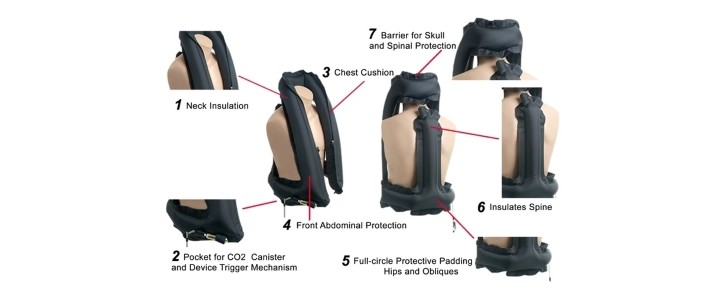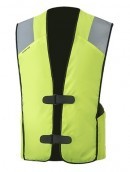Personal airbags are becoming increasingly popular, and more and more people are coming up with product ideas they hope to bring to mass production stage. Motoair Airbag One is a new project present on Kickstarter and which is aimed at making multiple sports safer.
Airbag One is an airbag vest that can be worn by motorcycle, ATV, snowmobile and even horse riders. It can go under the riding gear, but it can also be worn during warmer weather as an outer protective layer.
This airbag vest has a tubular bladder that surrounds the wearer's thorax and offers protection in multiple areas that may be exposed to injury during a fall. The bladder extends behind the neck, increasing protection in the upper back area and at the lower back of the skull.
It goes over the two collarbones and down across the ribs, towards the abdominal cavity. A 90-degree bend sees the two tubes of the air bladder reaching around the waist and becoming one over the spine. From this junction point, another piece extends upwards protecting the spine almost reaching the collar zone.
In fact, when not riding at a high speed, 0.18 seconds might be just enough time to add a layer of protection between your ribs and the obstacle you're about to hit. The problem is setting the Airbag One properly for the maximum efficiency.
Being a tether-activated system, Airbag One will only work if the safety pin is removed. This happens when the person wearing the Airbag One is about to become separated from the vehicle/horse, while the tether is attached at both ends. Once the tether reaches its maximum length, it will pull the safety pin and trigger the CO2 cartridge that inflates the bladder.
Wearing this vest on the bike requires that riders never forget about the tether, lest the airbag deploys when they step down or even when standing on the pegs. It looks like the cartridge is easily replaceable, but having the vest "popping up" inadvertently may be a distraction factor that can cause crashes itself.
Other manufacturers perfected this system, but they are having a rather hard time making it highly popular among riders. Apparently, people who are willing to add such protection to their daily rides prefer to go for the more expensive, but high-tech airbags. It's hard to believe that the Airbag One will float, even though its $189 (€173) price makes it significantly more affordable than others.
This airbag vest has a tubular bladder that surrounds the wearer's thorax and offers protection in multiple areas that may be exposed to injury during a fall. The bladder extends behind the neck, increasing protection in the upper back area and at the lower back of the skull.
It goes over the two collarbones and down across the ribs, towards the abdominal cavity. A 90-degree bend sees the two tubes of the air bladder reaching around the waist and becoming one over the spine. From this junction point, another piece extends upwards protecting the spine almost reaching the collar zone.
Tether-activated airbags have their shortcomings
Motoair claims that the airbag is fully inflated 0.18 seconds after being triggered. Not exactly in the tens of milliseconds zone Alpinestars and Dainese brag with, but definitely better than nothing at all.In fact, when not riding at a high speed, 0.18 seconds might be just enough time to add a layer of protection between your ribs and the obstacle you're about to hit. The problem is setting the Airbag One properly for the maximum efficiency.
Being a tether-activated system, Airbag One will only work if the safety pin is removed. This happens when the person wearing the Airbag One is about to become separated from the vehicle/horse, while the tether is attached at both ends. Once the tether reaches its maximum length, it will pull the safety pin and trigger the CO2 cartridge that inflates the bladder.
Wearing this vest on the bike requires that riders never forget about the tether, lest the airbag deploys when they step down or even when standing on the pegs. It looks like the cartridge is easily replaceable, but having the vest "popping up" inadvertently may be a distraction factor that can cause crashes itself.
Other manufacturers perfected this system, but they are having a rather hard time making it highly popular among riders. Apparently, people who are willing to add such protection to their daily rides prefer to go for the more expensive, but high-tech airbags. It's hard to believe that the Airbag One will float, even though its $189 (€173) price makes it significantly more affordable than others.






